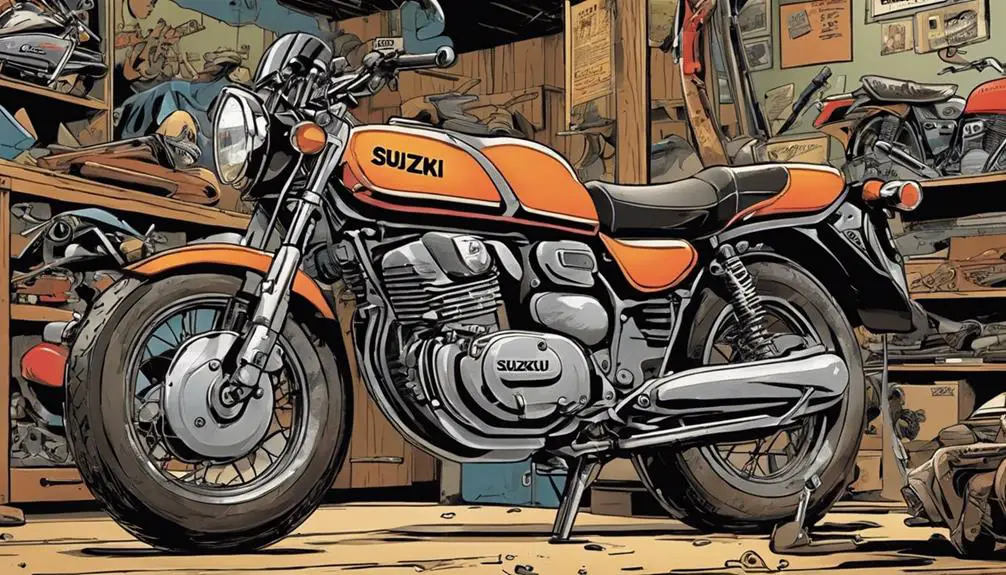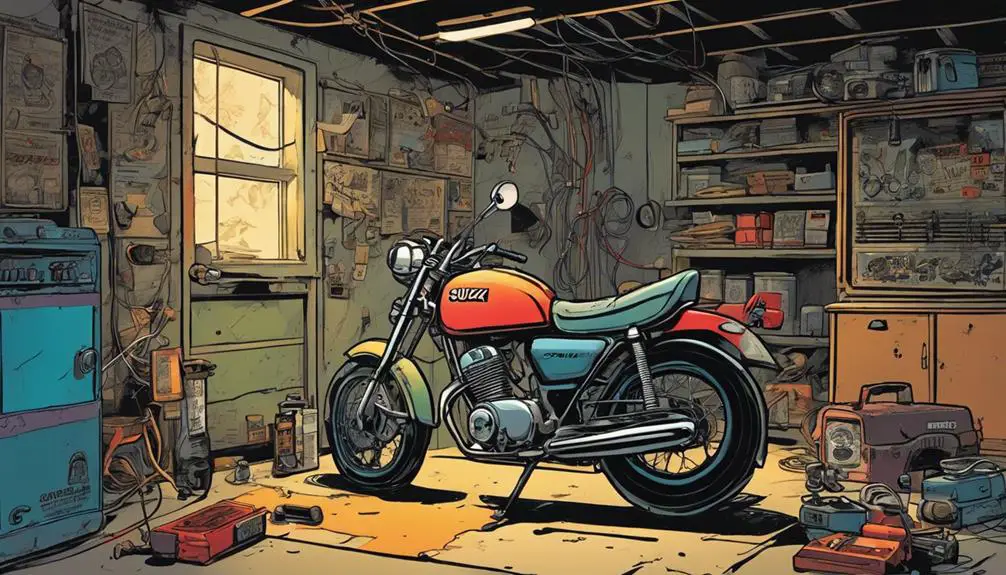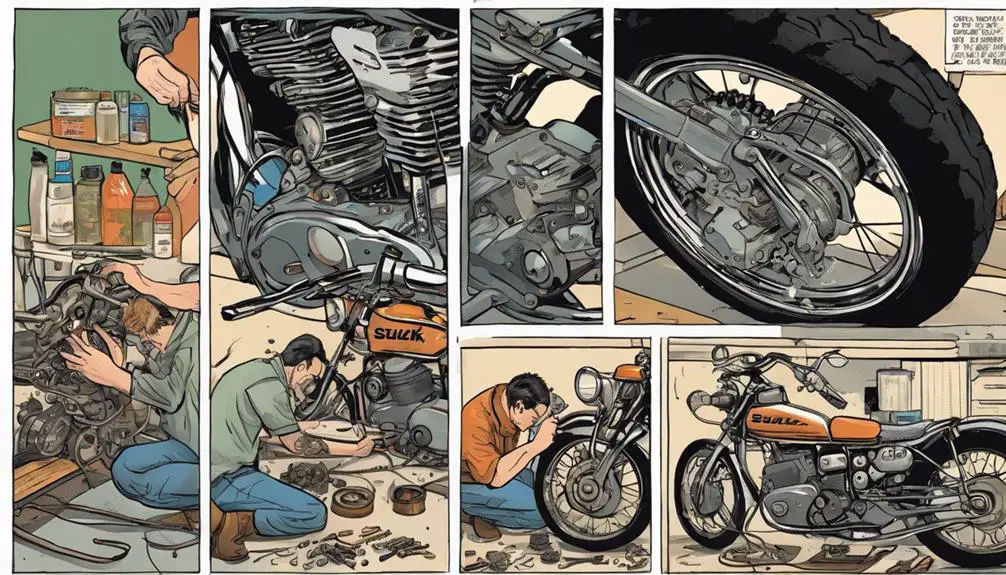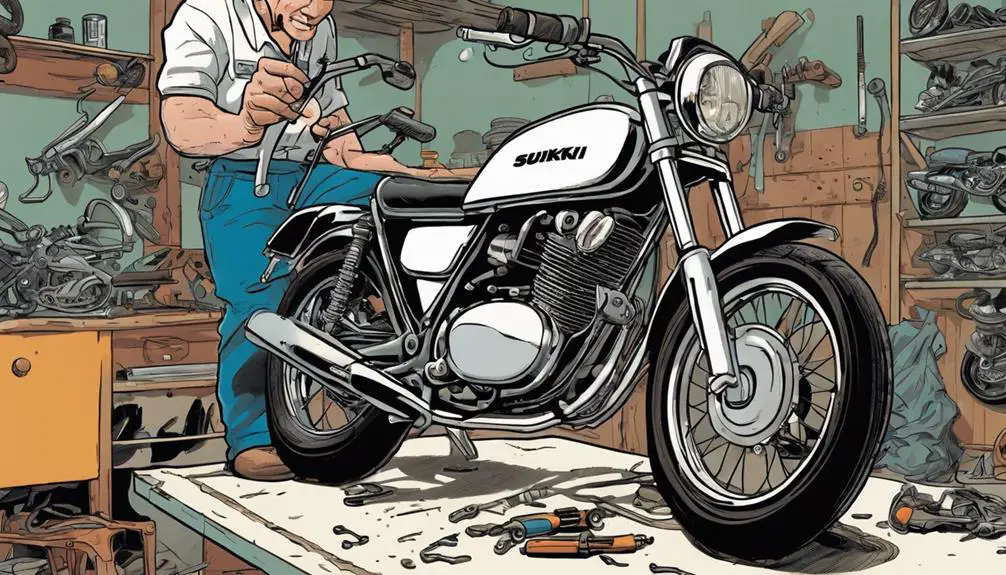A vintage Suzuki bike is like a time capsule, holding memories and stories that deserve care and attention. When you encounter issues, it's crucial to approach them methodically. Start by examining the fuel system for varnish buildup or checking the electrical connections for corrosion. These small steps can lead you to uncover more profound problems that might be lurking beneath the surface. As you work through these common concerns, you'll find that each solution might reveal yet another layer of complexity. What will you discover next in this journey?
Quick Takeaways
- Inspect and clean the fuel system, including lines, filters, and carburetors, to resolve performance issues caused by old fuel and clogs.
- Check the electrical system for corrosion at battery connections and inspect wiring for damage to ensure proper functionality of lights and ignition.
- Regularly maintain the transmission by checking clutch cables, oil levels, and changing contaminated oil for smooth shifting.
- Evaluate the brake system by checking fluid levels, inspecting for leaks, and assessing brake pads and rotors for wear or damage.
Understanding Vintage Suzuki Models

When exploring vintage Suzuki models, you'll find a rich history of engineering that shaped the motorcycle industry. Each model tells a story of innovation, passion, and a desire for freedom on two wheels. From the iconic Suzuki T500 to the sleek GS series, these bikes reflect a spirit of adventure that resonates with riders seeking liberation from the mundane.
As you immerse yourself in the specifics, notice the clever designs and unique features that set these models apart. The lightweight frames and responsive handling make them perfect for both city commuting and long-distance cruising. You'll appreciate the craftsmanship that goes into each bike, as Suzuki pushed boundaries to deliver performance and style.
You might find that vintage Suzuki motorcycles offer a sense of connection to the open road that modern bikes sometimes lack. They invite you to tune into the journey rather than just the destination. Whether you're restoring a classic or simply enjoying a ride, these machines embody a spirit of independence that calls to those who crave adventure.
Engine Performance Troubles
As you embrace the legacy of vintage Suzuki motorcycles, it's important to address potential engine performance troubles that can arise with age and use.
First, check the fuel system; old fuel can lead to varnish buildup, causing hesitation or stalling. Replace stale fuel with fresh, high-quality gasoline and clean or replace the fuel filter if needed.
Next, pay attention to the air filter. A clogged filter restricts airflow, hindering engine performance. Clean or replace it to breathe new life into your ride.
Don't overlook the spark plugs either. Worn or gapped plugs can lead to misfires and reduced power. Inspect them regularly and replace them if they show signs of wear.
Examine your carburetors as well. They may need a thorough cleaning or tuning after years of use. A poorly adjusted carb can lead to poor acceleration and fuel efficiency.
Lastly, consider engine oil quality. Old, degraded oil can impact lubrication and engine health. Change the oil regularly to keep your engine running smoothly.
Electrical System Failures

When you're facing electrical issues with your vintage Suzuki, it's essential to check battery connections first.
Loose or corroded terminals can lead to all sorts of problems.
Next, inspect the wiring for any signs of wear or damage that might be causing your bike to misbehave.
Battery Connection Problems
Inspecting the battery connections regularly can prevent frustrating electrical system failures in your vintage Suzuki bike. You've got to remember that a solid connection is essential for a smooth ride.
Start by checking the terminals for corrosion or loose connections. If you see any white or green buildup, that's corrosion, and it can disrupt the flow of power. Grab a wire brush or some baking soda mixed with water to clean it up. You want those terminals shining bright.
Next, make certain the cables are securely fastened. If you can wiggle them with your hands, they need tightening. Use a wrench to snug them up, but don't overdo it—too much force can damage the terminals.
Also, keep an eye on the battery itself. If it's old or worn out, it mightn't hold a charge. Consider replacing it if you notice any signs of age.
Lastly, don't forget to check the battery's voltage with a multimeter. It should read between 12.4 and 12.7 volts when fully charged.
Take these steps, and you'll be well on your way to enjoying the freedom of the open road without electrical worries.
Faulty Wiring Inspection
Faulty wiring can lead to a host of electrical system failures in your vintage Suzuki bike, so it's crucial to identify and address any issues promptly. Start your inspection by visually examining the wiring harness for any signs of wear, fraying, or corrosion. Look for loose connections, exposed wires, or broken insulation—these can cause shorts or intermittent failures that hinder your bike's performance.
Next, grab a multimeter and check the continuity of your wires. This'll help you pinpoint any breaks that might be hiding beneath the surface. If you find any bad connections, don't hesitate to clean or replace them. Use quality connectors and electrical tape to safeguard against moisture and further damage.
When you're done inspecting, test your bike's electrical components—lights, horn, and ignition system—to verify everything's functioning properly. If you still experience issues, consider consulting a wiring diagram specific to your model, as it can offer crucial insights.
Fuel System Issues
When you're experiencing fuel system issues with your vintage Suzuki, clogged fuel lines and carburetor tuning problems are likely culprits.
You'll want to check for blockages in the lines and guarantee the carburetor's settings are spot on.
Addressing these points can considerably improve your bike's performance.
Clogged Fuel Lines
Clogged fuel lines can disrupt the flow of gasoline to your vintage Suzuki, leading to poor performance and potential engine stalls. To reclaim your ride's freedom, start by checking the fuel lines for any visible signs of blockages or damage. If you see dirt, rust, or debris, it's time to clean or replace them.
Next, you'll want to inspect the fuel filter. A dirty filter can choke off the flow of fuel, so replace it if it's clogged.
After that, consider using a fuel line cleaning solution. These products can help dissolve deposits lurking in your lines, allowing your bike to breathe easier.
While you're at it, verify all connections are tight and leak-free. Loose fittings can introduce air into the system, causing erratic engine behavior.
Carburetor Tuning Problems
Carburetor tuning problems can drastically affect your vintage Suzuki's performance, causing issues like poor acceleration and rough idling. When your carburetor isn't set up right, it can lead to an imbalanced fuel-air mixture, robbing you of that exhilarating ride you crave.
Start by checking the float height; if it's too high or too low, you'll face flooding or starvation, respectively. Adjust it according to your bike's specifications.
Next, examine the pilot and main jets. Clogged jets can create hesitation and bogging down, while oversized jets can result in excessive fuel consumption. Cleaning or replacing them might be necessary to release your Suzuki's true potential.
Don't forget about the air-fuel mixture screw. A quarter-turn can make a significant difference in performance. If you're struggling to find that sweet spot, try small increments until you notice a change.
Lastly, inspect the throttle response. If it's sluggish, you might need to adjust the throttle cable or check for binding. Remember, tuning your carburetor isn't just about fixing issues; it's about setting your ride free, allowing it to roar down the road.
Transmission Problems

Transmission problems on vintage Suzuki bikes can really throw a wrench in your riding experience. If you're struggling with shifting issues, you're not alone.
First, check the clutch cable for any signs of wear or damage. A frayed cable can lead to poor engagement, making it hard to shift gears smoothly. Don't forget to inspect the clutch plates as well; if they're worn down, they may need replacing.
Next, take a look at the gearbox oil level. Low oil can cause sluggish shifting and even damage your transmission over time. If the oil looks dirty or contaminated, change it – clean oil is essential for a free-flowing transmission.
Listen for strange noises when you shift. Grinding sounds may indicate worn gears or insufficient lubrication. If you notice any leaks, track them down; they can lead to bigger problems down the road.
Brake System Concerns
After addressing transmission problems, you might find that brake system concerns can also impact your ride considerably. When brakes start to feel spongy or unresponsive, it's crucial to act quickly.
Begin by checking the brake fluid level; low fluid can lead to reduced braking power. If you notice leaks around the master cylinder or calipers, you'll need to replace those components to regain your ride's stopping ability.
Next, inspect the brake pads. Worn-out pads can compromise safety and performance, so replace them if they're too thin. Don't forget to check the rotors as well; warped or damaged rotors can cause vibrations and uneven braking. If you notice any unusual sounds, like squeaking or grinding, it's time to investigate further.
Lastly, confirm that the brake lines are in good condition. Cracks or wear can lead to brake failure, so replace worn lines immediately.
Tire and Suspension Checks

Checking your tires and suspension is vital for guaranteeing a smooth and safe ride on your vintage Suzuki bike. You want your journey to be liberating, not hindered by avoidable issues. Start with these essential checks:
- Tire Pressure: Make certain your tires are inflated to the recommended pressure. Under-inflated tires can lead to poor handling and increased wear, while over-inflated ones can cause a bumpy ride. Use a reliable gauge to get it right.
- Tread Depth: Inspect your tire tread for wear. If it's too shallow, you risk losing grip on the road, especially in wet conditions. A quick way to gauge tread depth is the penny test—insert a penny into the tread; if you can see Lincoln's head, it's time for new tires.
- Suspension Components: Check for any leaks or damage in your suspension system. Confirm the fork seals are intact and that the shock absorbers are functioning smoothly. A well-maintained suspension will enhance your bike's stability and comfort.
Maintenance Tips for Longevity
Regular maintenance not only keeps your vintage Suzuki bike running smoothly but also extends its lifespan, guaranteeing you enjoy many more rides without unexpected breakdowns.
Start with regular oil changes; clean, fresh oil is essential for engine health. Check your air filter often; a clean filter assures peak airflow, boosting performance.
Don't neglect your chain. Regularly clean and lubricate it to prevent wear and tear. Inspect and adjust your brakes frequently; effective brakes are imperative for your freedom on the road.
Keep an eye on your tires too; proper inflation and tread depth secure safety and enhance handling.
Be mindful of your bike's electrical system. Regularly check connections and battery health to avoid starting issues.
Seasonal checks can help; before winter, consider using a battery maintainer to preserve your power source.
Common Questions
What Are Common Signs of Vintage Suzuki Bike Restoration Needs?
When you're checking your vintage Suzuki bike, look for signs like rust on the frame, worn tires, or leaking fluids.
You might notice the engine's not starting smoothly or the brakes feeling spongy.
Inspect the electrical system for flickering lights or weak signals.
If the paint's chipped or faded, it's time for a fresh coat.
These signs signal it's time to restore, bringing your ride back to its former glory.
How Can I Find Replacement Parts for Vintage Suzuki Models?
Did you know that over 80% of vintage motorcycle enthusiasts struggle to find replacement parts?
To locate parts for your vintage Suzuki, start by checking online marketplaces like eBay or specialized forums.
Join local vintage bike clubs, where members often share leads on rare components.
Don't forget to explore salvage yards or shops that focus on classic bikes.
With persistence, you'll uncover the parts you need to keep your ride alive and free!
Are There Specific Tools Needed for Vintage Suzuki Bike Maintenance?
When maintaining your vintage Suzuki bike, you'll need a few essential tools.
Grab a good set of metric wrenches and sockets, as they fit most nuts and bolts.
A torque wrench guarantees you don't over-tighten any parts, while a multimeter helps diagnose electrical issues.
Don't forget pliers, screwdrivers, and a quality oil filter wrench.
With these tools, you'll feel empowered to keep your bike running smoothly, reclaiming your ride with confidence!
What Oil Should I Use for My Vintage Suzuki Motorcycle?
Choosing the right oil for your vintage Suzuki motorcycle is like picking the right fuel for a roaring fire; it fuels your ride's spirit.
You'll want to use high-quality, multi-viscosity oil, preferably 10W-40 or 20W-50, to keep that engine purring.
Don't forget to check the owner's manual for specific recommendations.
With the right oil, you'll release your bike's true potential, ensuring smooth rides and the freedom you crave on the open road.
How Do I Identify My Vintage Suzuki Bike Model?
To identify your vintage Suzuki bike model, start by checking the frame's serial number, usually found near the steering head.
Compare this number to Suzuki's historical records online or in enthusiast forums.
Look for unique features like the shape of the gas tank, seat design, and engine specifications.
You can also consult vintage bike communities; they're often passionate and knowledgeable.
Immerse yourself and embrace the freedom of discovering your bike's identity!
Wrapping Up
To sum up, keeping your vintage Suzuki running smoothly requires attention to detail and regular maintenance.
After all, isn't it worth preserving the charm and character of your classic ride?
By addressing engine performance, electrical issues, and more, you can enjoy the thrill of hitting the open road without worry.
Remember, a little care goes a long way in ensuring your bike remains a reliable companion for many more adventures ahead.